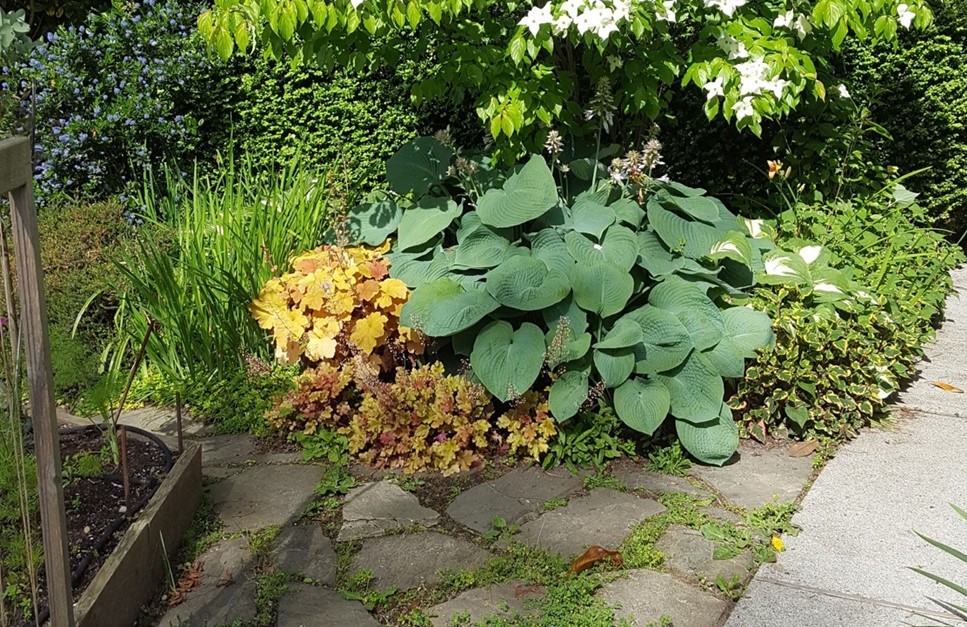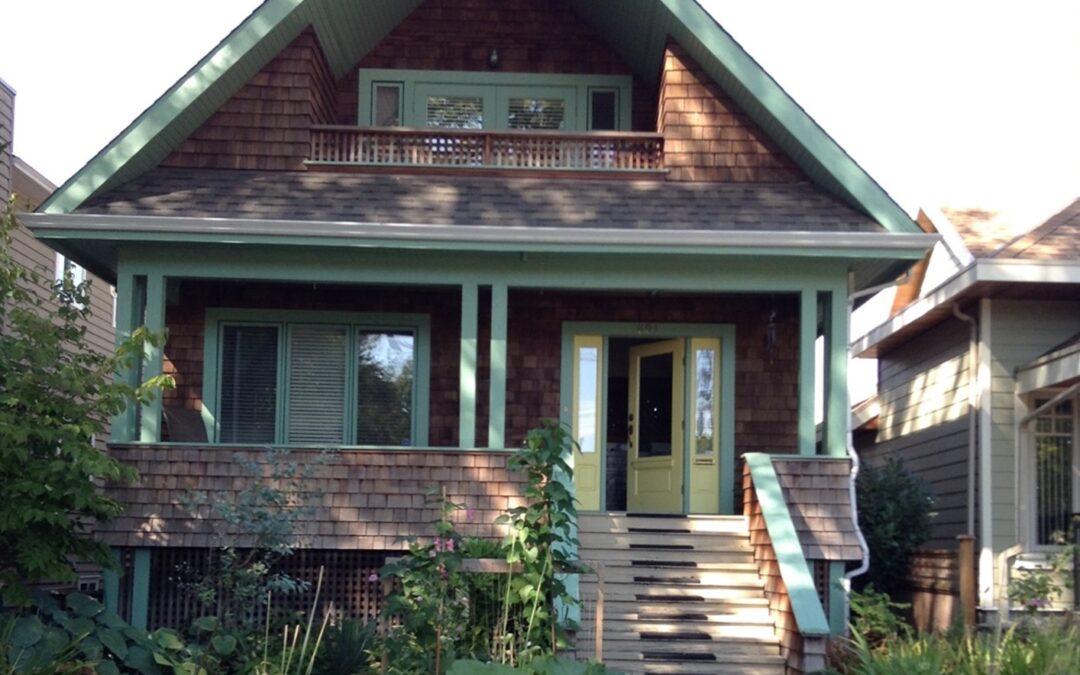Hear the author read this article (12:12)
Twelve years ago this past spring, Mary had the lawn at the front of our house transformed into a set of raised beds. This garden turned out to be part of a broader transformation in our lives that has something to do with staying put rather than moving around.
First, about the garden, a garden of good heart as the title suggests. Associating good heart with fields and gardens comes from an historic use of the term in the border counties of England and Scotland during an era when crops were cultivated and animals grazed on commonly held and governed land. In the most general sense, the term describes fields or gardens that are healthy and productive, but, interestingly, because it refers to land in use by a community, it also reflects attitudes, values and social relations. Land use was shaped by an ongoing dialogue in communities and the local customs were forged by these conversations. I picked up the term good heart from a delightful book by BC author Heather Menzies entitled Reclaiming the Commons for the Common Good.
In years when our garden is in good health you can picture two large food producing beds and two smaller beds with re-wilded plants and flowers, a currant bush and a row or two of late blooming dahlias. Rhubarb with its thick stalks and elephantine leaves is the featured performer in the front large bed that runs parallel to the sidewalk. Adjacent to rhubarb, rows of lettuce and kale are interspersed with nasturtiums and marigold adding colour and discouraging pests. In the large bed behind it and closer to the house, now known as Snowdrop Cottage, potatoes dominate some years and beans others.
What qualifies this garden as a garden of good heart? Very soon after it made its presence known I found that when I worked in the garden people passing by would stop to chat. Sometimes, it would be as simple as an encouraging compliment, “Beautiful garden.” Sometimes, a visitor would reminisce about the gardens of her childhood. Sometimes, people from faraway lands wanted to know the names of various plants.
And then, there started to be regular visitors, Gary and Vivian with a tiny dog called Obi that quickly formed a bond of friendship with Mary and me, Ellen who lives down the street inspecting this year’s crop, Theresa, the homeless woman who lived in the park opposite the garden for several years. One day a visitor told me that checking out our garden was part of the itinerary of her annual visit to Vancouver. The warmth and supportiveness of these visits touched my heart and deepened my sense of what neighbourhood can be.
Before living at Snowdrop Cottage, I had been a nomad for most of my adult life. Many of the non-indigenous population of BC are nomads like me who have succeeded settlers in inhabiting the unceded and ancestral lands of Indigenous nations; in my case, the xʷməθkʷəy̓əm (Musqueam), sḵwx̱wú7mesh (Squamish), and sel̓íl̓witulh (Tsleil-Waututh) Nations. Though we use the term settler to identify our non-indigenous status, many of us have skated across the topography of this land without deepening our connection to it and, ultimately, learning how to take responsibility for its care. And so, in fact we could be called unsettled nomads.
The most definitive years of my upbringing took place in Rexdale, a sprawling suburban area on Toronto’s western flank. The suburbs of the 1950’s were culturally non-descript, inducing a feeling of restlessness, a kind of “I can’t wait to get out of here feeling.” A counterpoint of this affluent era was a feeling of spiritual bankruptcy. What did it all mean? What was it for? I became a wanderer, a rolling stone. Hamilton, Toronto, Newcastle, Pittsburgh, San Francisco, Vancouver with no direction home. Only now, after all these years, have I connected to the earth in the way that a garden requires, and consequently feel more at home.
Gardens teach. After several years of good crops our garden’s productivity began to wane. The kale looked miserly, the beans laconic and many plants refused to grow at all. Pests chewed on the plants that did grow. Our compost which typically renewed the fertility of the soil made no difference. Eventually our friend Jimmy Shao, an experienced gardener, identified the culprit. Our otherwise friendly nearby Beech tree and the Dogwood tree on the edge of the flagstone patio had invaded the raised beds. A vast and intricate net of hair-like tiny roots just below the surface was sucking the life out of the soil. The solution required digging out the beds and lining them with garden paper that blocks roots while letting moisture in and out. Hard work But, here the magic of the garden prevailed again. During the summer and fall, Jimmy and Norman, another stalwart friend, volunteered to help me dig down below the roots. As the old saying goes, many hands make light work…..and some fun as well. The work extended into fall and then winter. Mary harped at me about “that pile of dirt that’s just going to wash away with the snow.” Despite her reservations, the project got done in early spring and all the dirt piled over the paper lining and the new plants tucked in, waiting for summer sun.

Dogwood tree whose roots extended under the garden.
Gardens teach. There is something very special about bringing food from the garden to the table, out with a basket and scissors and in with an evening’s dinner salad. A recipe asks for thyme and the garden provides. One year, the lettuce was so prolific, I took a dozen heads to the local Salvation Army hostel. Another year, I put out lettuce and herbs in a box on the seat of an old tricycle in the front yard at the corner of one of the beds with sign that said, “Free from Red Tricycle Gardens.” The free offerings from the garden were gone in an hour. Last summer the hot sun resulted in drought but also a longer growing season so we could make tomato soup from all the carefully watered fresh tomatoes.
I could not account, however, for the tree at the right corner door of the ancient garage at the alley. It grows prolifically trespassing on our neighbour’s backyard and setting off my car’s rear obstacle warning beeps with its wild obstreperous branches. One year I decided that it was enough. I cut it down to the roots and poured bleach over the remaining stubs! In the spring it grew back even more vigourously.
Eventually, I remembered an old site plan for the property that showed an underground spring on the tree’s side of the property. The tree’s roots must access a steady supply of life renewing water even in drought conditions. This tree is determined, resilient and resourceful.
Indigenous peoples worldwide seem to understand their interconnectedness with the natural world. At the same time the modern extractive economy is capable of destroying the environment through damaging practices such as clear-cut logging, tailing ponds at mine sites, and global warming by burning fossil fuels. Our garden taught me how disconnected I once was from the habitat that sustains me and the people in my immediate surroundings, my neighbourhood. Staying put and working the land in the form of our garden has begun to restore this connection for me.
When I look for the roots of this widespread disconnection, one source to which the Menzies book mentioned above introduced me was the enclosure of lands held and worked in common and their shift in status to private property. This was based on the misconception that the self-serving motivation of privately owned property would inevitably result in greater productivity and better maintenance, a belief that our present situation belies.
The lesson my garden teaches is ultimately about the communal and unifying nature of growing food. And, on a more material level, as we face a time of climate change induced food insecurity, the significance of growing food locally is apparent.
We are surrounded by new condominiums that are beginning to house many people – families, couples, elderly folks and singles. As I lift my eyes up from the soil I imagine the park across the street governed by the neighbourhood and filled with beds of flourishing, life giving plants and orchards grown organically just outside our doors. Fresh produce and fruit for everyone plus the wonderful opportunity to participate in building gardens.
Seeds, soil and tools. Dirty hands, smiling faces.
 Dr. Arden Henley is well-known in the Lower Mainland for his family therapy work and his development of programs for youth as well as his service as Vice President of City University of Canada. He is widely published and is currently the CEO of the Green Technology Education Centre (GTEC).
Dr. Arden Henley is well-known in the Lower Mainland for his family therapy work and his development of programs for youth as well as his service as Vice President of City University of Canada. He is widely published and is currently the CEO of the Green Technology Education Centre (GTEC).


